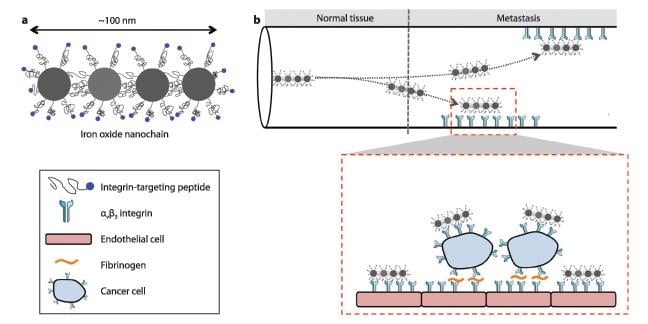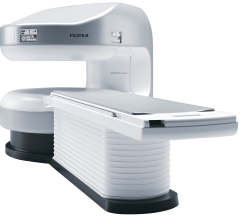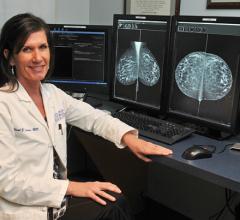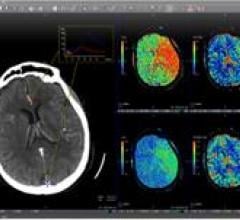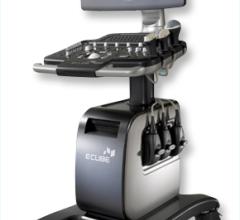At least a few Europeans think ventilation MRI should be commonplace.
ECRI Institute released a report listing three key questions and the answers concerning breast-specific gamma imaging (BSGI; sometimes referred to as molecular breast imaging or MBI). The technology uses a specially designed gamma camera system to image the uptake of a tracer that emits gamma radiation (most commonly 99mtechnetium-sestamibi [MIBI]). MIBI is preferentially taken up by cancer tissue, and thus BSGI can be used to image breast cancer for a variety of clinical indications. Unlike X-ray mammography, BSGI is not affected by the density of breast tissue, and therefore it may be particularly useful for screening and diagnosis of breast cancer in women with dense breast tissue.
Even though the vast majority of cancer mortality is due to metastatic disease, clinical practice indicates that current imaging tools are capable of detecting large metastases (about 0.5-1 cm in size), but rarely detect the early spread of metastatic tumor cells. Unfortunately, by the time cancer metastasis becomes clinically evident with today’s imaging techniques, the metastatic disease has progressed at a late stage prohibiting early successful interventions such as surgery or radiation. This late detection results in an unfavorable long-term patient outcome. For example, the five-year survival rate of breast cancer patients sharply decreases from 98 percent in cases with localized primary lesions to 23 percent in cases of distant large metastases.
Fujifilm’s APERTO Lucent is a 0.4T mid-field, open MRI system addressing today’s capability and image quality needs ...
I can be more precise with the ATEC biopsy device,” explains Jason Gatewood, M.D., Lead Interpreting Radiologist at the Saint Luke’s South Hospital Goppert Breast Center. “I don’t have to force it, and that gives me more control of the needle allowing me to be precise.” Dr. Gatewood has experience with most of the biopsy devices available for ultrasound guidance, and prefers the ATEC vacuum-assisted breast biopsy device. “The ATEC biopsy device has multiple advantages which allow it to be used in any scenario for breast biopsy, including dense breasts, cystic masses, random masses and small lesions.”
Creating the world’s first and only simultaneous whole-body positron emission tomography/magnetic resonance (PET/MR) scanner was no small feat for Siemens Healthcare. But when my engineering colleagues and I began that long, arduous development process more than half a decade ago, we believed that if we succeeded in building such a system, they — specifically, the clinical community — would come.

SPONSORED CONTENT — Fujifilm’s latest CT technology brings exceptional image quality to a compact and user- and patient ...
The next generation of positron emission tomography (PET) imaging agents will herald an age when PET will eclipse single photon emission computed tomography (SPECT) as the “go to” modality for molecular imaging. It will do so by enabling personalized medicine through precision diagnostics, the ability to be delivered cost-effectively in a manner with less radiation to patients, by leveraging hardware advances already being commercialized, and by taking advantage of the extra throughput capacity present in the U.S. installed base of PET/CT scanners.
SPONSORED CONTENT — Fujifilm’s latest CT technology brings exceptional image quality to a compact and user- and patient ...
Serving a 10-county region in southeastern North Carolina, Carolina Regional Radiology (CRR) is a full-service imaging and interventional radiology practice. Based in Fayetteville, N.C., and performing 500,000 exams annually, the practice has 22 board-certified radiologists who provide radiology services to several hospitals and imaging centers, as well as numerous physician practices and clinics.
If you are part of a health system that has spent months building and designing a new picture archive and communications system (PACS), it is undoubtedly an exciting time. Reaching the point of PACS activation and getting staff up and running is a true milestone. Once your company reaches this point, it may feel like the hard work is over and that it is time to take a deep breath, but in reality there is still much more to do and questions that have to be answered in order to fully support your organization during and post PACS go-live.
The application of cloud-based solutions to medical image management has come a long way in the last few years. Customer perceptions are evolving at a rapid pace, while cloud-hosted applications and managed service offerings are strengthening and diversifying. A “cloud version” (in any of its many flavors, including data center-hosted and/or Web-based zero-footprint clients, or thin clients using server-side processing) exists today for virtually every common image management function. This includes picture archiving and communication system/radiology
SPONSORED CONTENT — EnsightTM 2.0 is the newest version of Enlitic’s data standardization software framework. Ensight is ...
Digital direct radiography (DR) is significantly more effective than computed radiography (CR) at detecting breast cancer, according to a new study published online in the journal Radiology.The findings are the first to show a difference between the two types of digital imaging when compared with screen film mammography and suggest that women should be informed of the potential for lower cancer detection with CR, the researchers said.
The American Society of Nuclear Cardiology (ASNC) testified at a U.S. House Ways and Means Health Subcommittee hearing that examined options for repealing the sustainable growth rate (SGR) formula and reforming the Medicare physician payment system to reward quality and value in patient care. Kim Allan Williams, M.D., ASNC past-president and a current member of the society’s health policy steering committee, testified as a witness in the hearing on May 7, 2013. Williams currently serves as the Dorothy Susan Timmis endowed professor and chairman of the division of cardiology at Wayne State University School of Medicine.
During the American College of Cardiology 2013 (ACC.13) annual meeting in March, vendors discussed several trends they are observing in the cardiac ultrasound market and displayed the latest echo advances.
Did you know that approximately one-third of all the data in world is created by the healthcare industry and that ...
A new method of dynamic, personalized intravenous hydration significantly reduces the percentage of contrast-induced kidney injury from image-guided cardiovascular procedures, according to the results of the POSEIDON clinical trial presented as a late-breaking clinical trial at the SCAI 2013 Scientific Sessions.
Visage Imaging Inc signed a five-year agreement with vRad (Virtual Radiologic), one of the world’s largest radiology groups. VRad has more than 400 radiologists read 7 million radiology studies annually, and it will implement the Visage 7 Enterprise Imaging Platform as a central component of its technology platform focused on delivering a real-time environment.
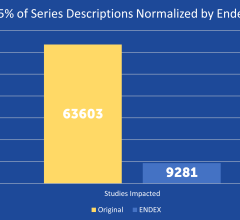
SPONSORED CONTENT — EnsightTM 2.0 is the newest version of Enlitic’s data standardization software framework. Ensight is ...
Alpinion Medical Systems has introduced the portable E-Cube 7 ultrasound system for use in guidance during regional anesthesia and pain medicine procedures. The launch marks Alpinion's emergence into the U.S. market.
With an average satisfaction score of 4.5 out of 5 on security, cloud users feel safe. Non-cloud users though remain at bay-particularly with many questions still looming around the future of cloud computing in healthcare. The KLAS report titled Cloud Computing Perception 2013: The Hybrid Cloud in Healthcare looks at the evolution of the cloud in healthcare, provider concerns, as well as vendor performance.
Royal Philips Electronics showcased its latest addition to the ClearVue ultrasound family of products at the American College of Obstetricians and Gynecologists 61st Annual Clinical Meeting in New Orleans May 4-8, 2013. The ClearVue 650 is a lightweight and cost-effective system that spans a range of applications from obstetrics and gynecology to cardiology, abdominal, vascular, breast, musculoskeletal, urology and general imaging.
Hologic, Inc. announced the publication of the final results of a large-scale prospective study comparing breast cancer screening using Hologic’s 2D mammography plus tomosynthesis (Breast Tomosynthesis) with conventional 2D mammography published online in advance of print by The Lancet Oncology.
Lung cancer is associated with very high mortality, in part because it is hard to detect at early stages, but also because it can recur frequently after surgical removal. The question arises as to what is the best way to follow lung cancer patients after surgery in order to spot problems early enough, before symptoms become obvious, so that patients may still be eligible for new interventions. In this study presented at the 93rd AATS Annual Meeting, investigators from the University of Toronto departments of Thoracic Surgery and Diagnostic Radiology show that minimal dose computed tomography (MnDCT) of the thorax offers much greater sensitivity at detecting new or recurrent lung cancer, with equivalent amount of radiation, compared to conventional chest X-rays.
NinePoint Medical, Inc., an emerging leader in the development of medical devices for in vivo imaging, announced that it has received an additional 510(k) clearance from the U.S. Food and Drug Administration (FDA) for its Nvision VLE Imaging System, expanding the system’s indication to include imaging of esophageal tissue microstructure. In Jan. 2012, the company announced 510(k) clearance from the FDA to market its Nvision VLE Imaging System for use as an imaging tool in the evaluation of human tissue microstructure by providing two-dimensional, cross sectional, real-time depth visualization.

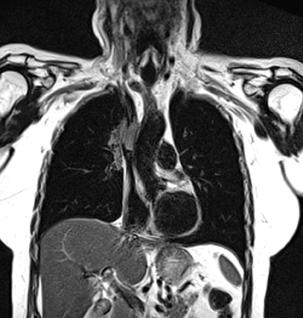
 May 15, 2013
May 15, 2013 

